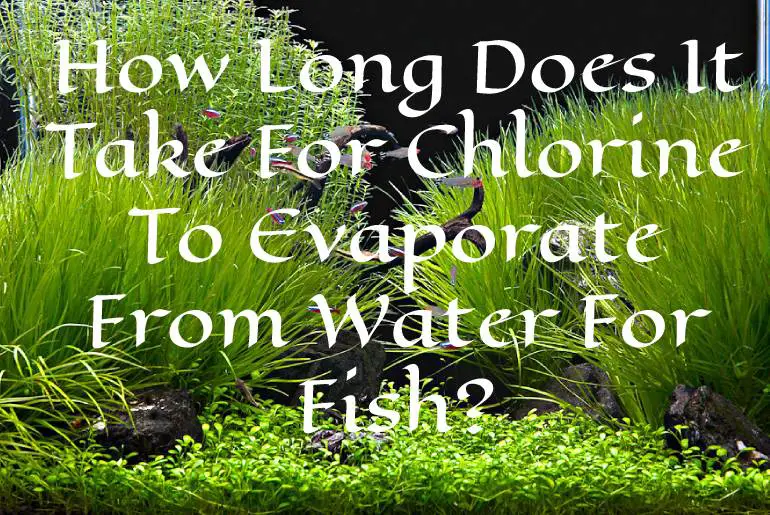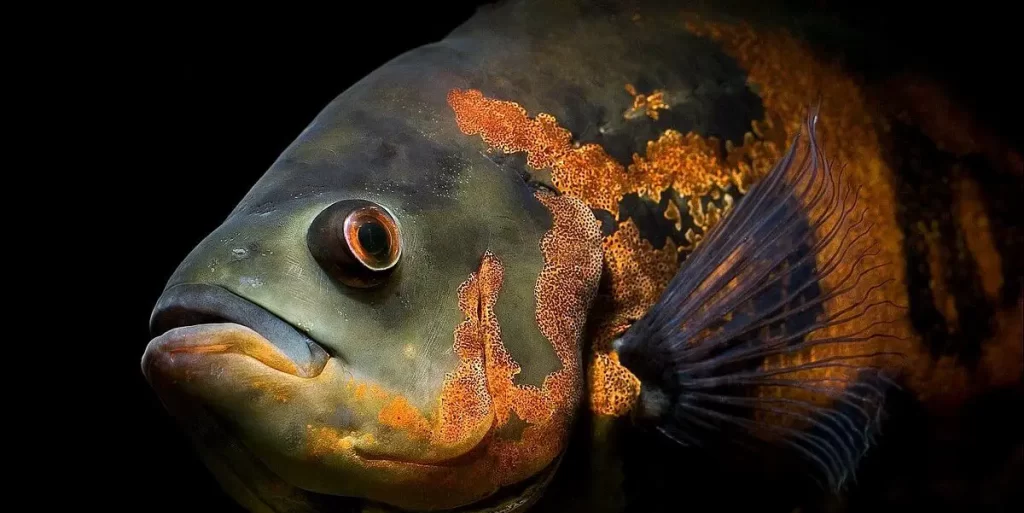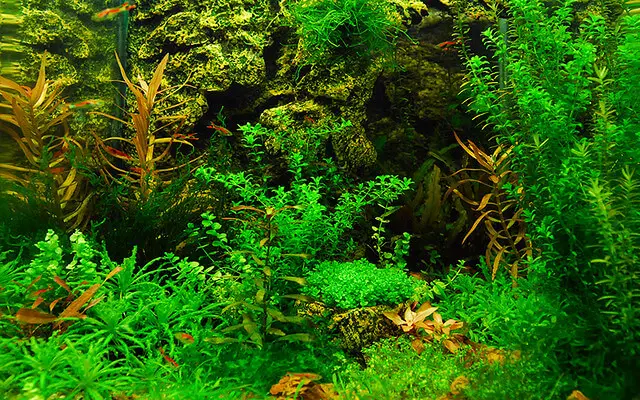When people are setting up the tank for the first time, they often take every little precaution. But most of the time, we aquarists get stuck in the very first thing we need for the tank: WATER. No one will ever be sure which water is the best for the aquarium but there are many we certainly need to avoid. Chlorinated water is always a big no. So we need to wait for the water to dechlorinate on its own. But how long does it take for chlorine to evaporate from water to be safe for fish?
The evaporation of chlorine from the water depends on the amount of chlorine present in the water. If you are using tap water, then the chlorine present in the water will evaporate within 24 to 48 hours. However, the hours may vary when there is a high amount of chlorine content in the water.
You need to understand things differently and know what is going on when the evaporation or even chlorination is taking place.
A little knowledge can be dangerous and you need to know more about the time interval of dichlorination of water and furthermore.
I have tried to accumulate all the information I can find in different headings to make it easier for you to understand.
Let’s dive in to know more about this topic.
How Long Does It Take For Chlorine To Evaporate From Water For Fish?
Well, as I have made it clear earlier in the article that the time required for the chlorine to evaporate from the water depends on the amount of chlorine present in the water.
Here is an article on How To Stop Water Evaporation In My Aquarium? : Causes And Remedies
You need to test the water more often to make sure the chlorine is absent from the water entirely. The ideal time to let the water sit and chlorine evaporate is between 24 to 48 hours.
If you leave your water to sit for 1 or 2 days, the chlorine present in the water will evaporate slowly. After 2 days there will be no mere presence of chlorine in any water.
The tap water supposedly contains the chlorine that is used to make the water clean and safe for a human to drink.
But that chlorine is a big no for the fish, so it is often suggested to keep the tap water still for 24 hours undisturbed to make it safe for the fish to live in.
It can also get extended up to 120 hours or 5 days if the chlorine contains in the water is higher than usual.
Make sure to test the water properly for all the chemicals that are harmful to fish. If you see the presence of any chemicals such as ammonia, nitrite, or even chlorine, do not pour that water into the aquarium.
Here is a similar article you might like to read How Long Does Chlorine Stay In Water?
Why Is Chlorine Bad For Fish?
Chlorine is well known to be one of the harmful chemicals for your fish. It may not affect human beings when taken in a lesser amount but for fish, the slightest hint of chlorine is equal to a slow poison.
Chlorine is known to cause acute necrosis in the fish which means the living tissues and organic matter present in the fish body starts to die as soon as they come in contact with Chlorine.
The chlorine present in the water will damage the gills of your dear fish as well as destroy the outer skin surfaces.
I can assure you that the consequences of this stunt of adding water with chlorine ion to the tank will not be a pleasant one for you.
Even experts are against the use of chlorine-based disinfectants in the tank as it can cause the death of your fish.
Here is the list of things that will happen to your fish when they come in contact with the chlorine present in the water:
- They will start to swim erratically and will try to escape from that water and even jump out of the tank.
- Irritation
- Incorrect body positioning
- Hypoxia
- Gill tissue necrosis
- Neurologic errors
- Sudden death
How Much Chlorine Can Fish Tolerate?
Well, people often come to me and ask if the slightest chlorine content will harm your fish. I barely can give them the hardcore answer because chlorine is in point of fact toxic to the fish.
But there is a certain limit of chlorine that fish can tolerate. And if I tell them that they might neglect any fluctuation in the number too.
Hence, I suggest them to make water chlorine-free and let it evaporate completely. Now, coming to the level of chlorine your fish can handle.
Trust me it is so low that it is easier to make water chlorine-free after reaching that limit. When it comes to adult fish, 0.1 ppm.
1 mg/L is the maximum level of chlorine you are allowed to have in the water for your fish. Your fish will be okay till the chlorine level is less than or equal to 1mg/l.
However, there is an exception as well. You have heard of Hardest Koi, right? Yes, that koi can handle 25 mg/l of chlorine present in the water along with some other pond fish.
Back to the aquarium life, it is necessary to maintain the chlorine level between 0.001 to 0.003 ppm. Even the level between 0.1 to 0.3 ppm is very lethal for your fish present in the tank.
That’s why to avoid any complications make sure your aquarium water is most probably chlorine-free. And if you fail to make the water chlorine-free, try to at least make it between or below 0.001 to 0.003 ppm to avoid health issues due to this strong oxidant.
How Long Does It Take For Chlorine To Evaporate From Tap Water For Fish?
The time your tap water needs to be safe for fish depends on the amount of chlorine they have used in it.
If the chlorine content is high, then the days might increase. However, most of the time the evaporation rate is the same as any other water.
You will have to let your tap water sit for 24 hours at room temperature without disturbing it. It will even take less than 24 hours if there is very less amount of chlorine content.
The level of concentration of the chlorine and the volume of tap water you need to keep in the tank are the main factors that decide the time interval to let the tap water sit undisturbed.
Sometimes, you will have to wait for more than 5 days in order to get chlorine-free water. The chlorine in the water will most probably evaporate within 24 to 48 hours.
But do not take the risk and make it harder for your fish. Even tap water can be a curse for the aquarium if you miss any opportunity to make it safe for your fish.
Test the water regularly for the days you are letting it sit. Wait till there is no hint of chlorine present in the water that can affect your fish health and raise complications.
I have also written an article on Why is Tap Water Not Safe For Fish? & How to Make It Safe? Tap water for fish
Other Methods To Remove/Evaporate Chlorine From Water
Sometimes people often lose patience when they are trying to start an aquarium. And I can understand the excitement of having an aquarium full of fish as soon as possible.
So, when it comes to waiting for the aquarium water to be perfect and chemical-free, you cannot waste any more time.
Even 2 days wait can feel like a decade. So, I will give you instant solutions to remove chlorine as well as the stubborn Chloramine from the water you are going to use.
Water Conditioner
There are many types of water conditioner which are known to remove all the chlorine as well as chloramine.
However, your water softener will not work on its own so you will have to have a good filtration system in the tank.
Your water softener will although remove all the magnesium, calcium, and iron present in the water. You have to go for a water conditioner that has activated carbon in it.
This will make your work faster and easier than you think. KDF 55 Filtration Media is one of the best you can get in order to remove chlorine from the water.
Boiling
Now, coming to the easiest, cheapest as well as fastest method to remove or evaporate all the Chlorine along with chloramine present in the water.
Most of the time, the chlorine will evaporate after a day or two from the water. But, the stubborn chloramine stays no matter how long you leave the water sit undisturbed.
So if you want to proceed with the fishkeeping hobby faster, go for this idea. Boiling has always been the first and last resort for a human being to get clean and drinkable water.
Hence, this boiling technique also works for clearing out the chloramine present in the water along with chlorine.
Take 10 gallons of water and boil it for 8 minutes straight. This will remove 1 ppm of chlorine present in the water.
Test the water and boil it simultaneously till all the chlorine and chloramine present in the water will evaporate.
Carbon Filtration
Activated carbon has the potential to remove all the chemical pollutants present in the tank. Not only chlorine or chloramine but also all the other chemicals that will hamper the fish health, activated carbon will remove all of them.
So, get a filter that has carbon filtration media pre-installed in it. But remember to test the water in order to maintain the pH of the aquarium.
Adding Ascorbic Acid
Now, coming to the easiest plus the economical way to remove all the chlorine present in the water. But first Remember to purchase a good quality ascorbic acid from Amazon.
Here is what you need to do: Add 1 teaspoon of ascorbic acid per gallon of water in the tank. This will neutralize the chlorine gas present in the water without hampering the oxygen concentration.
This will be the fastest way for you to get rid of chlorine without changing any dynamic of the tank and within the tank.
Ultraviolet Light
This one is for the ones who have extra money to spare. Trust me, this will be one of the expensive things that you will do for your tank.
This will hamper your budget as badly as it will even ask for you to change the bulb more often and this bulb is quite expensive to purchase.
However, UV rays will remove both chlorine and chloramine from the water after exposure within few minutes.
You have to treat your water with wavelength 254 nanometers UV rays that have a radiant energy density of 600 milliliters per 1 square cm.
Frequently Asked Questions
You might have more questions related to chlorine and its consequences in the aquarium. I have picked up a few of the FAQs and answered them to make it easier for you. Hope this helps.
Will Chlorine Kill My Fish?
Yes. This might sound harsh or over the top answer but this is the fact. Chlorine can kill your fish as it is quite toxic to any aquarium fish.
Have you heard about acute necrosis? If you haven’t, let me make it clear for you. Acute necrosis is the process your cell starts to die one by one almost immediately.
That’s what happens when your fish comes in contact with chlorine. Although, we, human beings, are quite immune to small amounts of chlorine and will have no problem dealing with tap water for daily use.
But the chlorine content in tap water is usually between 0.5 and 2.0 ppm which is way more than 0.0001 ppm. Your fish body will reacts to this chlorine as soon as they come in contact.
Hence, when this starts to occur, the living tissues will start to die and this will lead to the death of your fish present in the aquarium.
Can You Use Bottled Water For Fish?
Oh yes, you can use a gallon of bottled water for your tank but there is a catch. You need to treat your water with some water conditioner and let it sit for few days. Before pouring the bottled water into the tank, make sure the chemical content in the water is zero.
There are many water bottles that have iodine in them. And iodine or chlorine, any type of other chemical substitutes can bring death to your fish.
So, take necessary precautions and test the water quality before keeping that water for your fish. You can always go for 24 hours plan to let the water sit at room temperature to let the chlorine evaporate.
How Can I Test My Water For Chlorine At Home?
There are many options you can try in order to test chlorine present in the aquarium water at home. One of the easiest ones is to get a Chlorine test kit at home.
You can easily buy a chlorine test kit from any pet store or even order online. Sera Chlorine-Test and Quick and Accurate Water Test Strips – 7-1 Pool Test Kit, these two test kits will help you test the chlorine in the water at home in no time.
Also, there is a second option you can go for. This might not be as simple as test strips but are equally easier to perform.
All you have to do is purchase a testing liquid chemical named OTO i.e., orthotolidine. This chemical will change the color of the water to yellow if there is any chlorine present.
You have to take a test tube, fill it with the water you are about to use for the aquarium, and drop 4 to 5 drops of OTO in it.
If you see the water changing color, then your water still contains chlorine. So, you have to let it sit for few days before you use it in the tank.
This will be like a little science experiment you can even enjoy while taking care of your fish and making water safe for it.
Conclusion
In a nutshell, chlorine can be the death of your fish if you let it stay in the aquarium water. You must be cautious enough to check the chlorine content in any water you are going to pour into the tank. The simple process of evaporation for 1 or 2 days can save the life of your fish. It is never good to be impatient when it comes to fish keeping. Patience is the greatest virtue while you are raising fish in the tank. Be a good fish parent, and make sure they are getting everything optimum and best.
If you actually want things to go faster, try any of the other methods I have mentioned above. That will give you faster results and save your time. Although, I still suggest you let the chlorine evaporate on its own. This is the best and safest solution.
If you still have queries related to this, then drop them in the comment box below. I will try to answer them for you.
Good Luck!!
Happy Fishkeeping!!!






